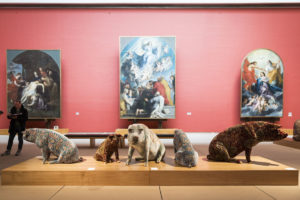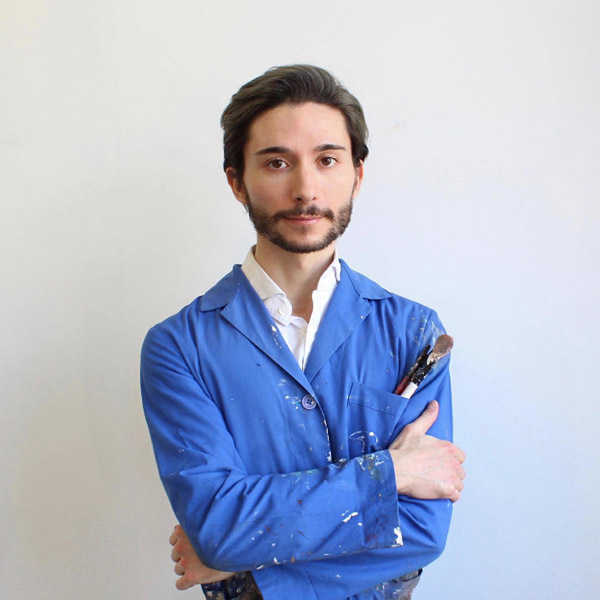The lattest exhibition by Belgian artist Wim Delvoye (Wervik, 1965) is familiar to the contemporary art audience for his often controversial art projects, which raise questions around the financial aspect of the art world and institutional critique, human rights, and the relationship between humans and animals. He also often flirts with contemporary art categories and movements – such as the abject and the uncanny, the shapeless and Postmodernism, Conceptual and Relational art – not without direct impacts on his own work, censored and contested on several occasions.
At the Royal Museums of Fine Arts of Brussels, Delvoye presents his most important solo show ever organised in Belgium. His works are shown on two levels of the museum, gathering his more controversial pieces on the underground level of the building, and a more recent body of works – fifteen sculptures – on the second floor, under natural light.
In the underground gallery and the permanent collection, next to works by masters like Brueghel, Rubens, van Dyck and Bosch, the approximately seventy artworks are highlights that represent Delvoye’s artistic evolution, developed along the last twenty years of his career. Looking at anamorphic crucifixes, digestive machines, and tattooed pigs, the visitor is invited to reflect upon the excesses of contemporary society and its paradoxes, as well as to consider the meeting points between different cultures, yet artistically and poetically close to each other.
The underground installation presents some recent works, such as marble bas-reliefs, Counter Strike and Fortnite (2018), as well as installations from the last decades – the stained–glass series Days of the Week (2008), and some videos – Sybille (1999). The most imposing installation is with no doubt Cloaca New and Improved (2001): a machine made of reactors and water pumps, powered with food two times a day, which is able to produce industrial faeces, aided by chemical products. Delvoye winks at leitmotifs from the Avant-gardes – Dada and Surrealism – or at artists who, before him, have used coprophilia in a playful way, such as Piero Manzoni, or Art Brut painter Mary Barnes.
The most controversial works remain, undoubtedly, the pigskin pieces. Between 2003 and 2010 Delvoye has created Art Farm China: a sort of pig retreat, where anaesthetised piglets were bred and tattooed. Covered with fashion logos, Disney-like iconography, and images inspired by Russian criminal tattoos, the animals were put on sale, their skin immediately becoming a commodity. The buyer would have become the owner of the pig and its skin, but only after the natural death of the animal. In the exhibition we see a sculpture and a video of the project, made in the farm, which had been moved from Belgium to China after legal complications. We see the pigs moving lazily within a room of the farm, their cries echoed in the gallery.
The visitor is eventually invited by Delvoye to cut himself off from reality, his perceptions being altered in the underground gallery, as well as seduced by skewed shapes, or by Gothic and Arab motifs. By merging art-historical and mass-cultural leitmotifs, the artist seems to reflect upon moral and religious tropes, such as transubstantiation, or upon financial trading rules, also applied to the art world. An exhibition permeated by a disenchanted Dada and Surrealistic black humour. A show that might leave you amused, puzzled, or both.
Elio Ticca
Info:
Wim Delvoye
curated by Pierre-Yves Desaive
March 22 – July 21 2019
Musées Royaux des Beaux Arts de Bruxelles
Rue de la Régence 3, 1000 Bruxelles, Belgio
 Wim Delvoye – Musées Royaux des Beaux Arts de Bruxelles. Vista dell’installazione. Courtesy Musées Royaux des Beaux Arts de Bruxelles
Wim Delvoye – Musées Royaux des Beaux Arts de Bruxelles. Vista dell’installazione. Courtesy Musées Royaux des Beaux Arts de Bruxelles
 Wim Delvoye, Cloaca New and Improved. Courtesy Musées Royaux des Beaux Arts de Bruxelles
Wim Delvoye, Cloaca New and Improved. Courtesy Musées Royaux des Beaux Arts de Bruxelles
 Wim Delvoye, Tabriz, Shahreza, Arak, Karaj, Khermanshah, Bidjar – Pieter Paul Rubens. Courtesy Musées Royaux des Beaux Arts de Bruxelles
Wim Delvoye, Tabriz, Shahreza, Arak, Karaj, Khermanshah, Bidjar – Pieter Paul Rubens. Courtesy Musées Royaux des Beaux Arts de Bruxelles

Elio Ticca (Nuoro, Italy, 1988) is a visual artist and author. Graduated in visual arts and history of art, is a freelance contributor of Juliet Art Magazine, and other publications. He lives and works in Brussels.






NO COMMENT